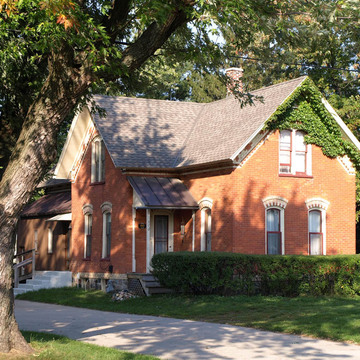The unique polychrome brickwork of this cross-shaped house on the flat farmlands of Zeeland reflects a patterning technique that pervaded West Michigan's “Dutch Kolonies,” particularly southern Ottawa and northern Allegan counties. The orange, red, and pale yellowish-white brick was manufactured in Zeeland by J. H. Veneklasen and Sons, later the Zeeland Brick Company. The company operated yards for red brick at Kalamazoo and in Hamilton (Allegan County) and for pale yellow brick at Zeeland (Ottawa County) and Cloverdale (Barry County). Decorative patterns in bricks of a color different from the walls are found along the gable, cornice, windows, doors, and base of the house. Their six varieties of window hoods and nine cornice and gable patterns were used interchangeably by builders, some of them appearing in this house. Skilled Dutch brick masons probably brought the building techniques from their homeland and built houses for their countrymen reminiscent of those in the Netherlands. Although the technique is most prevalent in farmhouses, it was also used in churches, schools, factories, and fire halls. Some 120 examples remain in the two-county region. The arrival of the Pere Marquette Railroad in 1872 permitted easy shipment of the brick to Chicago, Traverse City, Battle Creek, and elsewhere, and it contributed to the spread of polychrome brickwork.
You are here
Poest-Leeuw House
If SAH Archipedia has been useful to you, please consider supporting it.
SAH Archipedia tells the story of the United States through its buildings, landscapes, and cities. This freely available resource empowers the public with authoritative knowledge that deepens their understanding and appreciation of the built environment. But the Society of Architectural Historians, which created SAH Archipedia with University of Virginia Press, needs your support to maintain the high-caliber research, writing, photography, cartography, editing, design, and programming that make SAH Archipedia a trusted online resource available to all who value the history of place, heritage tourism, and learning.





